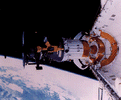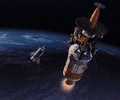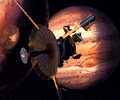
Galileo

 Environmental Testing
Environmental Testing
Before its shuttle launch, the Galileo orbiter was tested in a space
simulation chamber. The test chamber was designed to subject the craft
to approximately the same environmental conditions that it will
encounter in space.
 Final Assembly
Final Assembly
The Galileo spacecraft is being prepared for mating to its Inertial
Upper Stage, which will propel it on its six-year journey from the
Earth to Jupiter. The black and gold fabric that covers the spacecraft
is designed to protect it from both the heat of the sun and the chill
of interplanetary space. The conical structure near the bottom of the
spacecraft conceals the atmospheric probe, which will be dropped into
the Jovian atmosphere in 1995.
 Deployment
Deployment
The Galileo spacecraft and its Inertial Upper Stage booster rocket were
deployed from the space shuttle Atlantis October 18, 1989. Shortly
thereafter, the booster rocket fired and separated, sending Galileo on
its six-year journey to the planet Jupiter. Upon its arrival at Jupiter
in December 1995, Galileo will release a probe into the atmosphere so
that scientists can survey the composition of the planet's clouds. The
orbiter will relay probe information and will survey and photograph
Jupiter and some of its major satellites.
 The Journey Begins
The Journey Begins
This artist's concept depicts the Inertial Upper Stage booster rocket
firing shortly after its deployment from the shuttle
Atlantis. Galileo's complex trajectory to Jupiter flung it by Venus
once and then back to Earth for two fly-bys. Each pass added kinetic
energy to the spacecraft, increasing its velocity so that it could
reach Jupiter with a relatively small amount of fuel.
 Into the Clouds
Into the Clouds
Upon its arrival in December 1995, the Galileo spacecraft will release
an atmospheric probe into the clouds of Jupiter, giving scientists
their first glimpse into the planet's atmosphere. Meanwhile, the
Galileo orbiter will study and map Jupiter's major satellites from as
near as a few hundred kilometers and will monitor Jupiter's atmosphere
and magnetosphere.
 Galileo at Jupiter
Galileo at Jupiter
The Galileo spacecraft as it passed by Io, just prior to Jupiter orbit
insertion, is shown in this artist's rendering. The orbiter will use
the combination of a gravity assist from Io and a rocket thrust to
enter orbit. Between these events, the orbiter will relay to Earth
information received from the atmospheric probe descending through
Jupiter's clouds. Note that the high gain antenna (dish-shaped
antenna) will not be deployed as shown here, due to malfunction of the
deployment mechanism.

 Welcome to the Planets Home Page
Welcome to the Planets Home Page



 Environmental Testing
Environmental Testing  Final Assembly
Final Assembly  Deployment
Deployment  The Journey Begins
The Journey Begins  Into the Clouds
Into the Clouds  Galileo at Jupiter
Galileo at Jupiter 